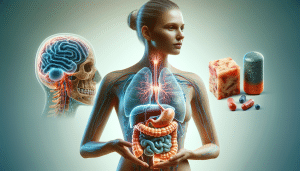Why Gut Health Might Be Your Wellness Gamechanger
Ella Knight September 16, 2025
Unlock the secrets of how optimizing gut health can transform your overall wellness and impact daily energy, immune function, and even mood. This approachable guide puts the science of the microbiome, probiotics, and whole-food eating habits into real-life context for anyone curious about improving healthy living.
What Makes Gut Health So Central to Wellness?
Modern research reveals that gut health is closely linked to multiple dimensions of well-being, making it a hot topic for anyone interested in healthy living. Inside every person is a vibrant community of trillions of microbes, collectively known as the gut microbiome. These tiny organisms do more than digest food—they help regulate immune responses, synthesize vital vitamins, and even influence mood via the gut-brain axis. It’s fascinating and, at times, surprising just how much this internal ecosystem shapes daily wellness. Many now believe that a balanced gut may be the foundation for clearer skin, sustained energy, and more resilient moods. Discussions around gut health increasingly center on its impact beyond digestion, weaving through concerns about chronic inflammation, immune function, and metabolic health (Source: https://www.hsph.harvard.edu/nutritionsource/microbiome/).
The relationship between food, microbiome populations, and our body’s natural defenses is especially intriguing. Scientists find that dietary fiber from a variety of plant-based foods provides essential fuel for beneficial microbes. These microbes, in turn, produce short-chain fatty acids, which help regulate immune function, reduce inflammation, and support the health of the gut lining. When the gut is in balance, people often notice improved digestion, fewer gastrointestinal symptoms, and—sometimes unexpectedly—an overall boost in energy. Even small lifestyle tweaks can make a big difference. It shows how the choices made at every meal ripple far beyond temporary hunger, influencing how well the whole body functions (Source: https://www.ncbi.nlm.nih.gov/pmc/articles/PMC5641835/).
Many people are surprised to learn the gut harbors around 70% of the body’s immune system. This means that whether one is seeking to avoid frequent colds or reduce risk of chronic disease, caring for the gut should be a top priority. It’s not just about probiotics in pills or yogurt—gut health means building routines, from managing stress to daily movement, that support a thriving inner ecosystem. Doctors and researchers recommend a diet stacked with plant diversity, fiber, and whole foods as a way to foster resilience and vitality from the inside out (Source: https://www.cdc.gov/nutrition/resources-publications/plant-based-diet.html).
Signs Your Gut Needs More Attention
Sometimes the body sends subtle signals that the gut might be out of balance. These signs are not always obvious or limited to occasional digestive discomfort. Common indications include persistent bloating, irregularity, heartburn, or unexplained fatigue. However, experts suggest even skin issues like eczema, brain fog, and frequent colds could be linked to what’s happening in the gut. Recognizing these clues allows for early interventions—working toward gut health restoration before symptoms grow more bothersome (Source: https://www.health.harvard.edu/blog/recognizing-and-managing-autoimmune-disease-2019050816656).
Cravings for sugary foods, energy crashes after meals, or difficulty managing weight are often overlooked hints that gut microbes might not be thriving. Some research suggests people with imbalanced microbiomes crave sugar more frequently, since certain bacterial strains rely on simple carbohydrates for survival. When the gut is out of balance, the brain-body connection can lead to cycles of craving and mood dips, making it harder to adopt new healthy habits. Experts promote listening to these patterns as potential calls for nutritional shifts (Source: https://www.ncbi.nlm.nih.gov/pmc/articles/PMC6520897/).
If recurrent illness, autoimmune challenges, or even stubborn acne persists despite other interventions, a closer look at gut health routines could prove helpful. Wellness practitioners often recommend building a simple journal of symptoms, meals, and daily routines for several weeks. Tracking these signs can offer new insight into patterns that tie back to gut well-being, setting the stage for more targeted choices. Evidence continues to mount that gut restoration is about small, steady changes rather than abrupt overhauls, and everyone’s signals may look a bit different (Source: https://nccih.nih.gov/health/probiotics/introduction.htm).
Foundations of a Gut-Supportive Diet
One of the most foundational strategies for cultivating gut wellness is shifting dietary choices toward fiber-rich, minimally processed foods. Increasing variety in fruits, vegetables, whole grains, nuts, and seeds introduces a broader spectrum of nutrients and plant fibers—exactly what beneficial microbes need to multiply. Many nutritionists emphasize that eating for the gut is about abundance, not restriction: the more plants, the better. This diversity promotes a resilient microbiome, enabling the body to better extract nutrients, synthesize vitamins, and manage inflammation (Source: https://www.eatright.org/health/wellness/preventing-illness/the-power-of-plant-based-eating).
Some people find that adding fermented foods—such as yogurt, kefir, sauerkraut, kimchi, or miso—contributes additional friendly bacteria, known as probiotics. These foods are increasingly popular in the world of wellness, but it’s the combination of both probiotics and prebiotic fiber (which feeds those good bacteria) that makes the biggest impact. Probiotic supplements are available, but experts caution to choose carefully and focus on a whole-foods approach first. Nutrition research finds that naturally occurring probiotics, balanced with plenty of fiber, set the stage for better gut stability and immune support (Source: https://www.mayoclinic.org/healthy-lifestyle/nutrition-and-healthy-eating/expert-answers/probiotics/faq-20058065).
Eating mindfully—slowing down, chewing thoroughly, and paying attention to hunger cues—helps both digestion and microbial balance. Studies suggest that stress at mealtimes or rushed eating may disrupt motility and decrease absorption of nutrients. There’s growing recognition that the rituals around eating, including sharing meals with others, can nurture not just the gut, but also emotional well-being. Gut health isn’t only about what’s on the plate but also how meals are experienced. Building a gut-friendly routine often starts with small, sustainable changes practiced daily (Source: https://www.ncbi.nlm.nih.gov/pmc/articles/PMC6839744/).
Beyond Food: Lifestyle Habits That Shape the Gut
While food choices play a starring role, several lifestyle tactics can influence gut health profoundly. Quality sleep, regular movement, and sound stress management all contribute to a balanced digestive ecosystem. Mounting evidence shows that both chronic sleep deprivation and unmanaged stress can tip the microbiome toward imbalance, sometimes setting off cycles of inflammation and discomfort. Cultivating a wellness routine that includes simple relaxation techniques, such as mindfulness or gentle yoga, has measurable benefits on the gut-brain axis (Source: https://www.ncbi.nlm.nih.gov/pmc/articles/PMC8070426/).
Exercise doesn’t just benefit the heart and muscles. Regular physical activity encourages diverse microbial communities and supports healthy digestion. Whether it’s walking, dancing, swimming, or cycle commuting, consistent movement can aid motility and reduce symptoms like bloating and constipation. Even modest activity is linked to lower gut inflammation and increased resilience—reminding us that a healthy lifestyle supports the gut as much as diet alone (Source: https://www.hopkinsmedicine.org/health/wellness-and-prevention/the-benefits-of-exercise-on-the-digestive-system).
Mind-body practices are increasingly recognized as essential for optimal gut health. Chronic stress can increase gut permeability (“leaky gut”), disrupt microbiota balance, and aggravate symptoms such as irritable bowel or discomfort. Activities such as meditation, nature walks, or creative hobbies act as powerful tools to buffer stress and protect gut well-being. Choosing even one stress-relief tactic and practicing regularly can ripple through the microbiome in positive ways. Wellness is truly a whole-body (and mind) project, with the gut as a vital focal point (Source: https://www.psychologytoday.com/us/blog/health-and-human-nature/202103/your-gut-health-could-boost-your-mental-health).
Creating a Sustainable Gut Wellness Plan
Building a gut-friendly lifestyle doesn’t have to mean overhauling everything at once. Experts advise starting where it’s easiest: adding a new plant-based food, swapping a snack for nuts or berries, or taking a daily ten-minute walk. Keeping change gradual increases the chances new habits will stick, making improvements manageable rather than overwhelming. Remember, every small upgrade in routine can affect the complex dance of microbes living within—and that’s empowering.
Personalization is central to long-term gut health. Because everyone’s microbiome is a little different, what works wonders for one may be less effective for another. Some benefit most from increasing fiber, while others find gentle exercise or stress relief brings tangible improvement. Tracking food, symptoms, and mood for a few weeks (even casually) can reveal unique insights and support smarter choices. Over time, people notice new patterns—maybe more energy, fewer cravings, easier digestion.
Seeking out credible sources, consulting registered dietitians, and keeping an open line with healthcare providers helps maintain progress. For most people, gut health evolves gradually, with seasonal adjustments and new learning along the way. Wellness doesn’t have a finish line. It’s a continual process—one that the science of gut health makes more clear, hopeful, and exciting than ever before.
References
1. Harvard T.H. Chan School of Public Health. (n.d.). The Microbiome. Retrieved from https://www.hsph.harvard.edu/nutritionsource/microbiome/
2. Durack, J., & Lynch, S. V. (2019). The gut microbiome: Relationships with disease and opportunities for therapy. Journal of Experimental Medicine, 216(1), 20–40. Retrieved from https://www.ncbi.nlm.nih.gov/pmc/articles/PMC5641835/
3. Centers for Disease Control and Prevention. (n.d.). Plant-Based Diets. Retrieved from https://www.cdc.gov/nutrition/resources-publications/plant-based-diet.html
4. National Institutes of Health. (n.d.). Probiotics: What You Need To Know. Retrieved from https://nccih.nih.gov/health/probiotics/introduction.htm
5. Mayo Clinic. (n.d.). Probiotics: What is it, Benefits, Side Effects, Food & Types. Retrieved from https://www.mayoclinic.org/healthy-lifestyle/nutrition-and-healthy-eating/expert-answers/probiotics/faq-20058065
6. EatRight. (n.d.). The Power of Plant-Based Eating. Academy of Nutrition and Dietetics. Retrieved from https://www.eatright.org/health/wellness/preventing-illness/the-power-of-plant-based-eating







